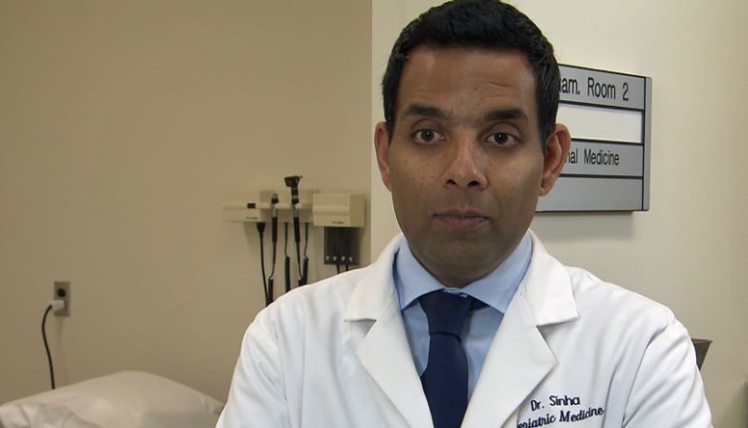40 dead from COVID-19 in Ontario nursing and retirement homes
Posted: April 2, 2020
(April 1, 2020)
By: Mike Crawley, CBC News
Outbreaks declared in at least 41 facilities for seniors, prompting calls to widen testing in homes

The Pinecrest Nursing Home in Bobcaygeon, Ont., is the scene of a COVID-19 outbreak that has claimed the lives of 14 residents and one volunteer worker. (Chris Glover/CBC)
At least 40 deaths of residents in Ontario nursing and retirement homes have been linked to COVID-19, almost triple the number that provincial officials reported on Wednesday.
The death toll jumped by 11 over the course of Wednesday, including six new deaths at one Toronto long-term care home and two others at a nursing home in Bobcaygeon.
The tally is based on information gathered by CBC News directly from Ontario’s 34 local public health units.
The public health units also say at least 41 facilities for seniors in the province are currently experiencing outbreaks of COVID-19, with an outbreak defined as one lab-confirmed positive test among a resident or staff member.
The growing number of outbreaks is raising fears that the pandemic will take more lives in long-term care homes.
As of Wednesday, the illness caused by the coronavirus had killed at least 41 people in Ontario and 107 countrywide, according to CBC’s own tracking of coronavirus data. The province’s official tally stood at 37 on Wednesday afternoon.
Dr. Barbara Yaffe, Ontario’s associate chief medical officer of health, said Wednesday afternoon that the province knows of 12 deaths among people in long-term care homes with confirmed cases of COVID-19, but acknowledged that local public health units have more up-to-date figures.
CBC News found that in addition to the deaths of 14 residents and one volunteer worker at the Pinecrest Nursing Home in Bobcaygeon as of Wednesday, there have been another 19 COVID-19-related deaths at long-term care and retirement homes stretching from Sarnia to Orleans.
“It’s heartbreaking because people in those homes are very vulnerable,” said Natalie Mehra, executive director of the Ontario Health Coalition, which includes health care unions and patient advocacy groups.
“It’s such a serious and deadly disease that I am very frightened for what’s going to happen across Ontario’s long-term care homes now.”
Virus may have spread by staff, visitors
Since the World Health Organization declared a pandemic on March 11, Ontario’s Ministry of Health progressively ramped up measures to try to keep COVID-19 out of long-term care and retirement facilities, first recommending screening visitors for symptoms and travel history, then advising homes against allowing any non-essential visitors.
However, there is concern that the virus may have been spread by staff or visitors who weren’t showing symptoms or by others before the restrictions were enforced.

Three residents have died and 11 have tested positive for COVID-19 at Anson Place Care Centre in Hagersville, about 40 kilometres south of Hamilton. (ansonplacecarecentre.ca)
“We acted immediately from the advice that we got from the chief medical officer of health,” Premier Doug Ford said Tuesday when questioned about the speed of the province’s response at his daily press conference.
“I just wish I had a crystal ball a month ago, a month and a half ago, to see where this was going. We’re doing everything we can to protect the most vulnerable.”
The measures “were appropriately timed,” said Dr. Samir Sinha, director of geriatrics for the Sinai Health System and a provincial advisor on seniors’ health issues.
“Now, we’re learning things in real time that it might have been better to do a week ago. That’s the reality of working in a pandemic.”
Urging mask use at all times
Based on fresh evidence from the U.S. Centers for Disease Control about asymptomatic transmission of the virus, Sinha is urging the province to further ramp up testing of nursing home residents and is recommending that long-term care staff wear masks at all times.
The number of officially confirmed COVID-19 cases in some Ontario nursing homes is almost certainly fewer than the actual number of cases, because of a previous provincial policy that prompted some homes to stop testing after a few residents were confirmed to have the disease.
For instance, at the Hillsdale Terraces long-term care home in Oshawa, where two residents have died, six have tested positive for COVID-19 and another 25 are showing symptoms of the respiratory illness but have not been tested, according to Glendene Collins, a manager in the Durham Region Health Department.
The province issued a new directive on Monday to homes to test everyone with symptoms in the event of an outbreak.
Sinha says Ontario should go further and test everyone in a long-term care home where there’s an outbreak.
“That’s important so that we don’t miss cases that could allow us to further spread this virus around and potentially kill more people,” he said, pointing to U.S. research showing many residents of long-tern care homes are testing positive for COVID-19 without having any symptoms.

‘We’re learning things in real time that it might have been better to do a week ago,’ said Dr. Samir Sinha, head of geriatric medicine at Toronto’s Sinai Health System. (CBC)
At least 41 outbreaks
The growing number of officially declared outbreaks around Ontario and the rising death toll “are showing that nursing homes are like tinderboxes,” Sinha said. “If the virus gets in, it can spread quickly and it can have devastating consequences.”
Mehra criticized the province for failing to have enough personal protective equipment, such as mask and gowns, available for staff of long-term care homes.
“The response has been terrible — very slow and without any real explanation as to what happened and why,” Mehra said.
“I think everyone understands that we’re dealing with a situation that no one anticipated. But I think we need a lot more information about what is the plan going forward. How are these things going to be dealt with?”
Click here for original article


